
The family Stylidiaceae is a taxon of dicotyledonous flowering plants. It consists of five genera with over 240 species, most of which are endemic to Australia and New Zealand. Members of Stylidiaceae are typically grass-like herbs or small shrubs and can be perennials or annuals. Most species are free standing or self-supporting, though a few can be climbing or scrambling.

Tolypangium is a subgenus of the genus Stylidium that is characterized by ovoid to longish capsules. This subgenus was part of the earliest taxonomic division among the triggerplants. Stephan Ladislaus Endlicher first split the genus into two subgenera in 1838: Tolypangium with its ovoid capsules and Nitrangium with its linear capsules. Subsequent authors generally followed this classification, which is based almost entirely on the features of the capsule. Recent genetic analysis, combined with an exhaustive morphological comparison, has revealed that the classification defined by Johannes Mildbraed in 1908 is not the most accurate description of how the members of different subgenera and sections are related. As part of the Flora of Australia series, Juliet Wege will be reviewing and updating the taxonomy of the Stylidiaceae.

Verticillatae is a section in the subgenus Tolypangium that is characterized by globose capsules. Recent genetic analysis, combined with an exhaustive morphological comparison, has revealed that the classification defined by Johannes Mildbraed in 1908 is not the most accurate description of how the members of different subgenera and sections are related. As part of the Flora of Australia series, Juliet Wege will be reviewing and updating the taxonomy of the Stylidiaceae.

Andersonia is a subgenus of Stylidium that is characterized by a linear hypanthium, recurved mature capsule walls, an erect and persistent septum, and many seeds. This subgenus occurs in areas of tropical northern Australia and into Southeast Asia and was named in honour of William Anderson, the surgeon and naturalist who sailed with James Cook.

Stylidium section Alsinoida is a taxonomic rank under Stylidium subgenus Andersonia. In his 1908 monograph on the family Stylidiaceae, Johannes Mildbraed had established the subgenus Alsinoides for species related to S. alsinoides, which were morphologically similar to species of subgenus Andersonia. In 2000, A.R. Bean published a taxonomic revision of subgenus Andersonia and reduced subgenus Alsinoides to sectional rank, renamed Alsinoida.

Stylidium section Tenella is a taxonomic rank in the plant kingdom under Stylidium subgenus Andersonia. In 2000, A.R. Bean published a taxonomic revision of subgenus Andersonia and established this section to separate these eleven species based on morphological and cladistic analysis. This taxonomic rank is named after George Bentham's series Tenellae, which he established in his 1869 treatment of the family Stylidiaceae. Series Tenellae was not used in Johannes Mildbraed's 1908 taxonomic monograph in which he completely revised the subgeneric taxonomy of the genus. Mildbraed's treatment of the genus taxonomy is the general demarcation which has been used in subsequent revisions and additions.

Stylidium section Debilia is a taxonomic rank under Stylidium subgenus Tolypangium. In his 1908 monograph on the family Stylidiaceae, Johannes Mildbraed had established this section as Debiles. In 1999, A.R. Bean published a taxonomic revision of several sections in subgenus Tolypangium in which he renamed the section from Debiles to Debilia.
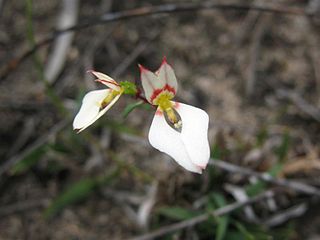
Levenhookia, also known as the styleworts, is a genus of ten recognized species in the family Stylidiaceae and is endemic to Australia. The genus is restricted to Western Australia almost exclusively with a few exceptions: L. pusilla's range extends into South Australia, L. dubia's range extends through South Australia into Victoria and New South Wales, L. sonderi is native only to Victoria, and L. chippendalei is also found in the Northern Territory.
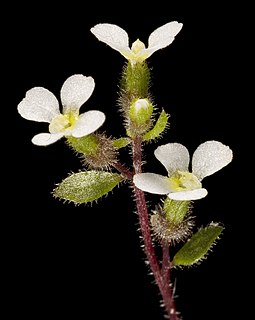
Levenhookia dubia, the hairy stylewort, is a dicotyledonous plant that belongs to the genus Levenhookia. It is an ephemeral annual that grows from 2–6 centimetres (0.79–2.36 in) tall with obovate leaves that are generally 2–5 millimetres (0.079–0.197 in) long. Flowers are white and bloom from September to October in its native range. L. dubia is most closely related to L. sonderi, which has been described as a variety of L. dubia in the past. It is endemic to Australia and has native ranges in Western Australia, South Australia, New South Wales, and Victoria. Its habitat has been reported as being sandy soils in granite outcrops.
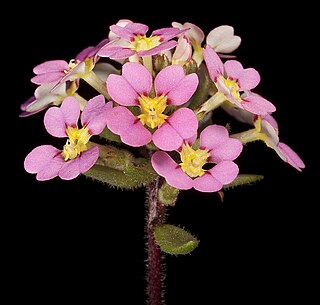
Levenhookia leptantha, the trumpet stylewort, is a dicotyledonous plant that belongs to the genus Levenhookia. It is an ephemeral annual that grows from 2–6 centimetres (0.79–2.36 in) tall with ovate to lanceolate leaves that are generally 2–5 millimetres (0.079–0.197 in) long. Flowers are pink and bloom from September to October in its native range. It is endemic to Western Australia. Its habitat has been reported as being sand or sandy clay soils in granite outcrops and winter-wet depressions.

Levenhookia pauciflora, the deceptive stylewort, is a dicotyledonous plant that belongs to the genus Levenhookia. It is an ephemeral annual that grows from 5–10 centimetres (2.0–3.9 in) tall with ovate to suborbicular leaves. Flowers are white and bloom from September to November in its native range. L. pauciflora is endemic to Western Australia where it grows in sandy soils in sandstone or granitic areas. The flowers of L. pauciflora resemble those of Stylidium ecorne and it has been said that S. ecorne mimics L. pauciflora to take advantage of its pollinators.
Levenhookia sonderi, the slender stylewort, is a dicotyledonous plant that belongs to the genus Levenhookia. It is an ephemeral annual that grows only in Victoria, Australia. L. sonderi is most closely related to L. dubia and it has even been described as a variety of L. dubia in the past. Johannes Mildbraed was the first person to reduce L. sonderi to a variety of L. dubia in his 1908 taxonomic monograph on the Stylidiaceae in which he noted he could not find any significant difference between L. sonderi and L. dubia to maintain the separate taxonomic treatment of the two species. Later studies have considered the species to be distinct.

Levenhookia stipitata, the common stylewort, is a dicotyledonous plant that belongs to the genus Levenhookia. It is an ephemeral annual that grows about 7–10 centimetres (2.8–3.9 in) tall with oblanceolate to linear leaves. Flowers are pink and bloom from August to January in its native range. L. stipitata is endemic to southwestern Western Australia where it grows in granitic or lateritic soils. This species was first described by George Bentham in 1837 as Stylidium stipitatum and was later reclassified into the genus Coleostylis, which was placed into synonymy with the genus Levenhookia.

Levenhookia sect. Coleostylis is a section of four recognized species in the family Stylidiaceae. It was established and described by Johannes Mildbraed in 1908 to separate the subgeneric taxonomy in the genus Levenhookia. Mildbraed originally placed L. preissii and L. stipitata in this section. L. chippendalei was described in 1966 and placed in this section by Rica Erickson and Jim Willis. Section Coleostylis could also contain L. octomaculata, which Erickson described in 1956, noting its affinities with L. stipitata but without placing it in a section. Otherwise it would be unplaced as to a section.
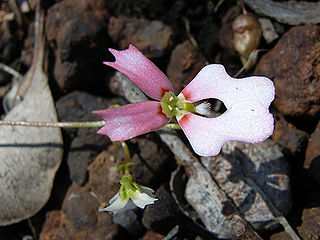
Stylidium calcaratum, the book triggerplant, is a dicotyledonous plant that belongs to the genus Stylidium. It is an ephemeral annual that grows from 5 to 10 cm tall but can grow larger at 20–30 cm tall in damp forest or scrub habitat. The few ovate leaves produced by this plant form basal rosettes around the stem. The leaves are around 3–5 mm long on short petioles. The scapes are 2–30 cm tall and produce single flowers in smaller plants and up to nine flowers in larger, more robust plants. Flowers are pink or white with red spots or lines at the individual petal bases. The petals are vertically paired and will fold over to meet each other at night or in adverse weather conditions. S. calcaratum is endemic to Australia and has a distribution that ranges from Victoria through South Australia and into Western Australia. Its habitat is recorded as being wet flats or near creeks and seepages. Pollination is achieved by a grey fly, Comptosia cuneata.
Stylidium imbricatum, the tile-leaved triggerplant, is a dicotyledonous plant that belongs to the genus Stylidium. It is an herbaceous perennial that grows from 12 to 50 cm tall and has divided stems covered with tile-like leaves that are arranged in a spiral formation around the stem. The ovate-elliptic leaves are basifixed and held closely against the stems. The leaves are around 1.5-1.8 mm long and 0.6-0.8 mm wide. Terminal inflorescences are racemose or spike-like and produce flowers that are reddish violet with laterally-paired lobes and bloom from April to May in their native range. S. imbricatum is only known from south-western Western Australia in Stirling Range National Park and Porongurup National Park south-east to Cheynes Beach. Its habitat is recorded as being sandy or laterite soils in swampy areas, rocky slopes, or heathland. S. imbricatum is distinct within its subgenus because it possesses obovate sepals. Its conservation status has been assessed as secure.
Stylidium leeuwinense is a species that belongs to the genus Stylidium. The specific epithet leeuwinense refers to the Cape Leeuwin region in Western Australia where the type location for this species is. It is an herbaceous perennial that grows from 15 to 60 cm tall and has divided stems covered with tile-like leaves that are arranged in a spiral formation around the stem. The lanceolate leaves are basifixed and held closely against the stems. The leaves are around 2.5-3.5 mm long and 0.5-0.8 mm wide. Terminal inflorescences are racemose or spike-like and produce flowers that are reddish purple with laterally-paired lobes and bloom from February to May in their native range. S. leeuwinense is only known from south-western Western Australia along the coast from Augusta to Denmark. Its habitat is recorded as being black, peat-sand soils in swampy areas or heathland. S. leeuwinense, along with S. preissii, is distinct within its subgenus because it possesses leaves without an apical mucro. It differs from S. preissii by its spike-like racemes.

Stylidium marradongense is a species that belongs to the genus Stylidium. The specific epithet marradongense refers to the Marradong region in Western Australia where the species is located. It is an herbaceous perennial that grows from 15 to 50 cm tall and has divided stems covered with tile-like leaves that are arranged in a spiral formation around the stem. The lanceolate leaves are basifixed and held closely against the stems. The leaves are around 1.5-2.0 mm long and 0.5-0.8 mm wide. Terminal inflorescences are racemose or spike-like and produce flowers that are shades of pink or white with pink at the base of the lobes and bloom from September to November in their native range. S. marradongense is only known from south-western Western Australia from Mount Saddleback to Marradong. Its habitat is recorded as being sandy laterite soils in open jarrah forest with other species such as Banksia grandis, Banksia sessilis, and Persoonia longifolia. S. marradongense is closely associated with S. preissii because they both lack throat appendages. It differs from S. preissii by its spike-like racemes, apical mucro, and conical, capitate stigmas.
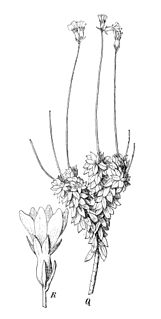
Forstera is a genus of small perennial plants in the Stylidiaceae family named in honour of the German naturalists Johann Reinhold Forster and his son, Georg Forster, who had previously described Forstera's sister genus, Phyllachne just five years earlier. It comprises five species that are endemic to New Zealand with the exception of F. bellidifolia, which is endemic to Tasmania. The species in this genus resemble those in a subgenus of the related genus Stylidium called Forsteropsis, but they are more closely related to the genus Phyllachne. Proposals to merge the two genera based on information from cladistic analysis have emerged because of these genera's morphological similarities and evidence that they are paraphyletic.

Stylidium affine is a species in the genus Stylidium that is endemic to Western Australia.















